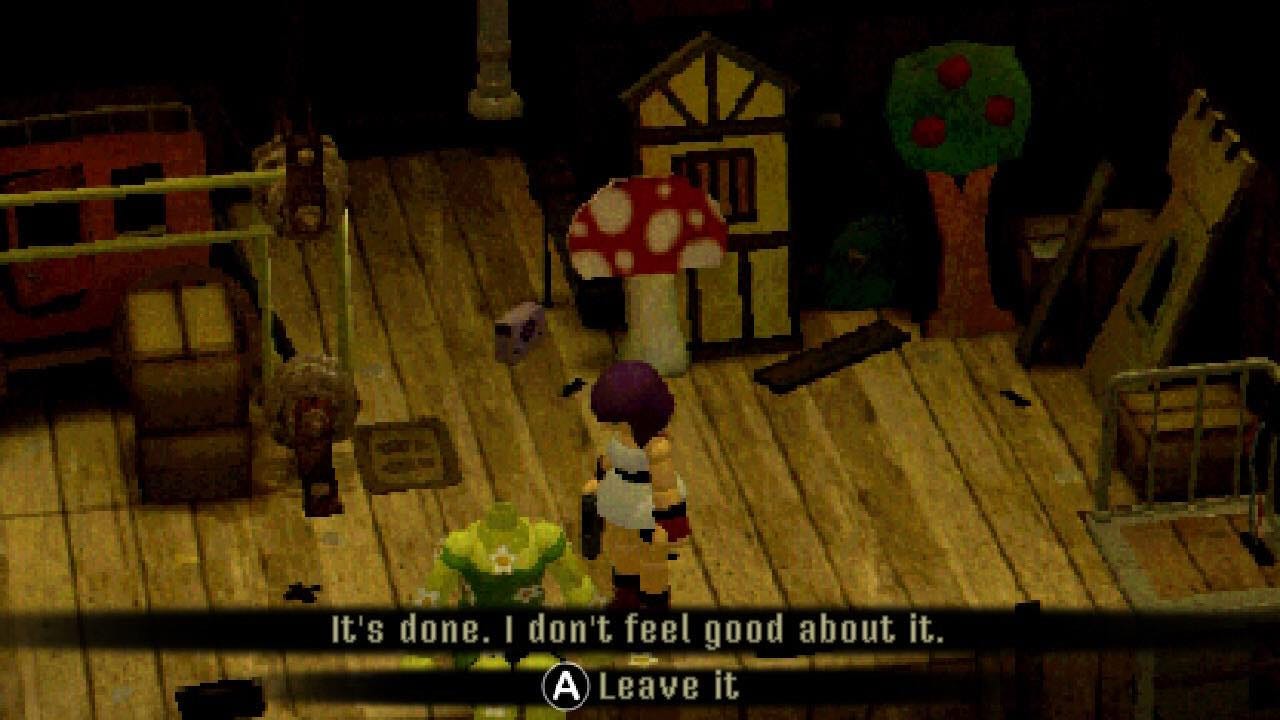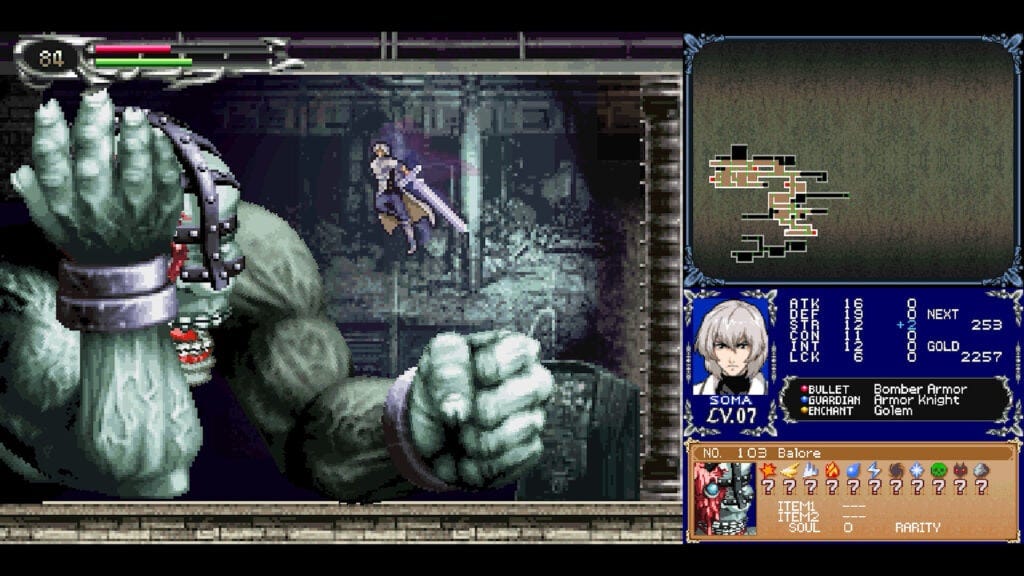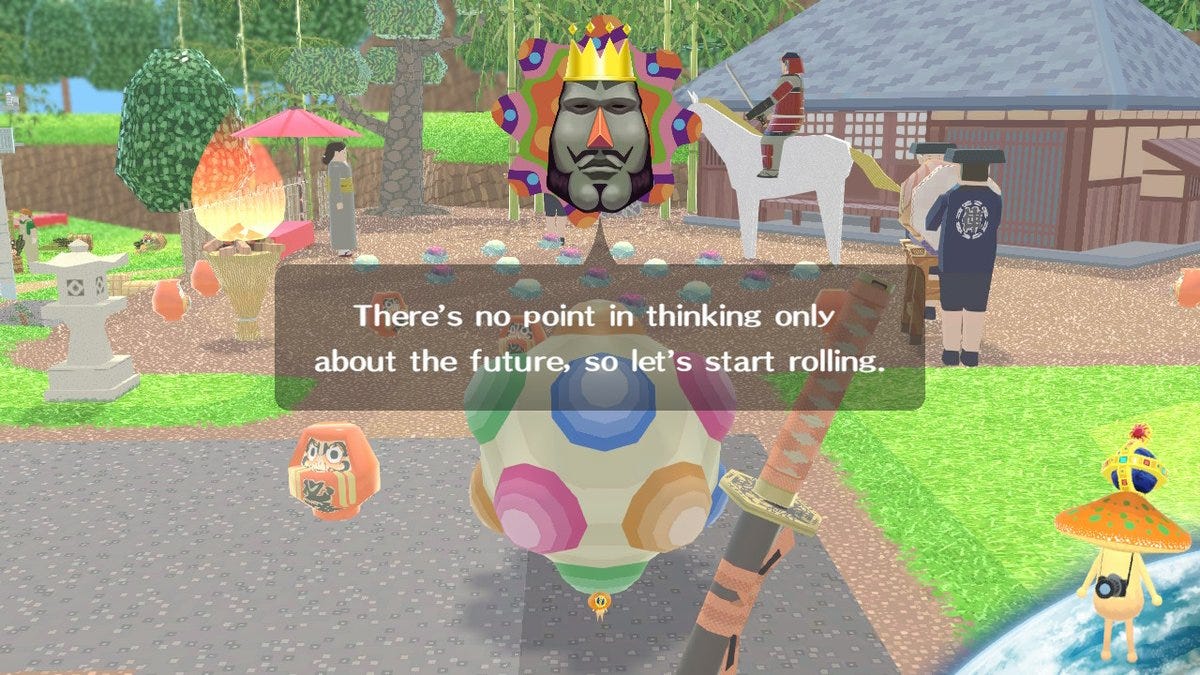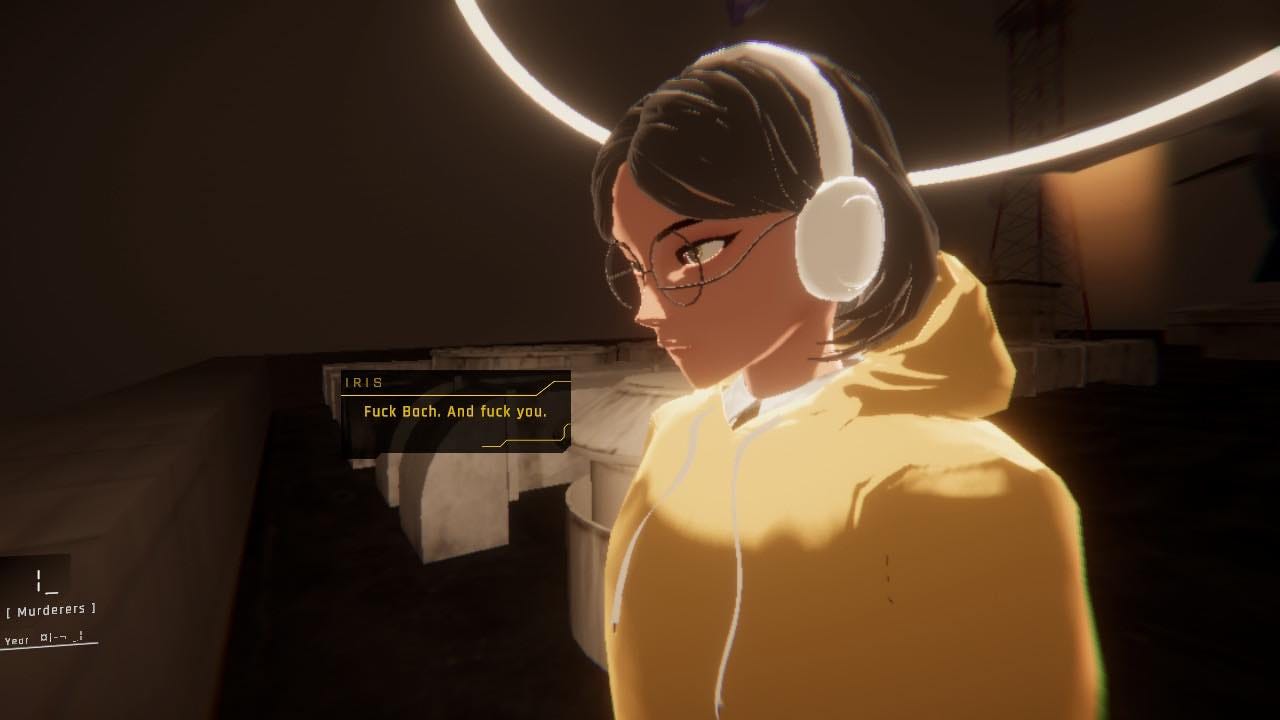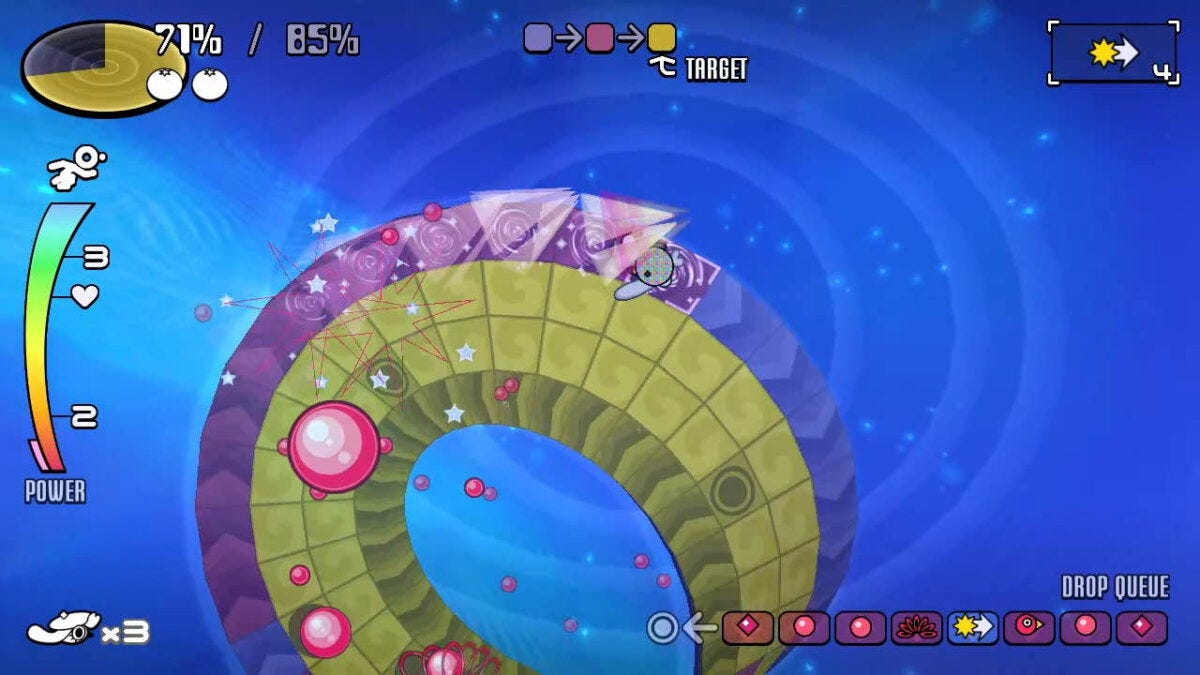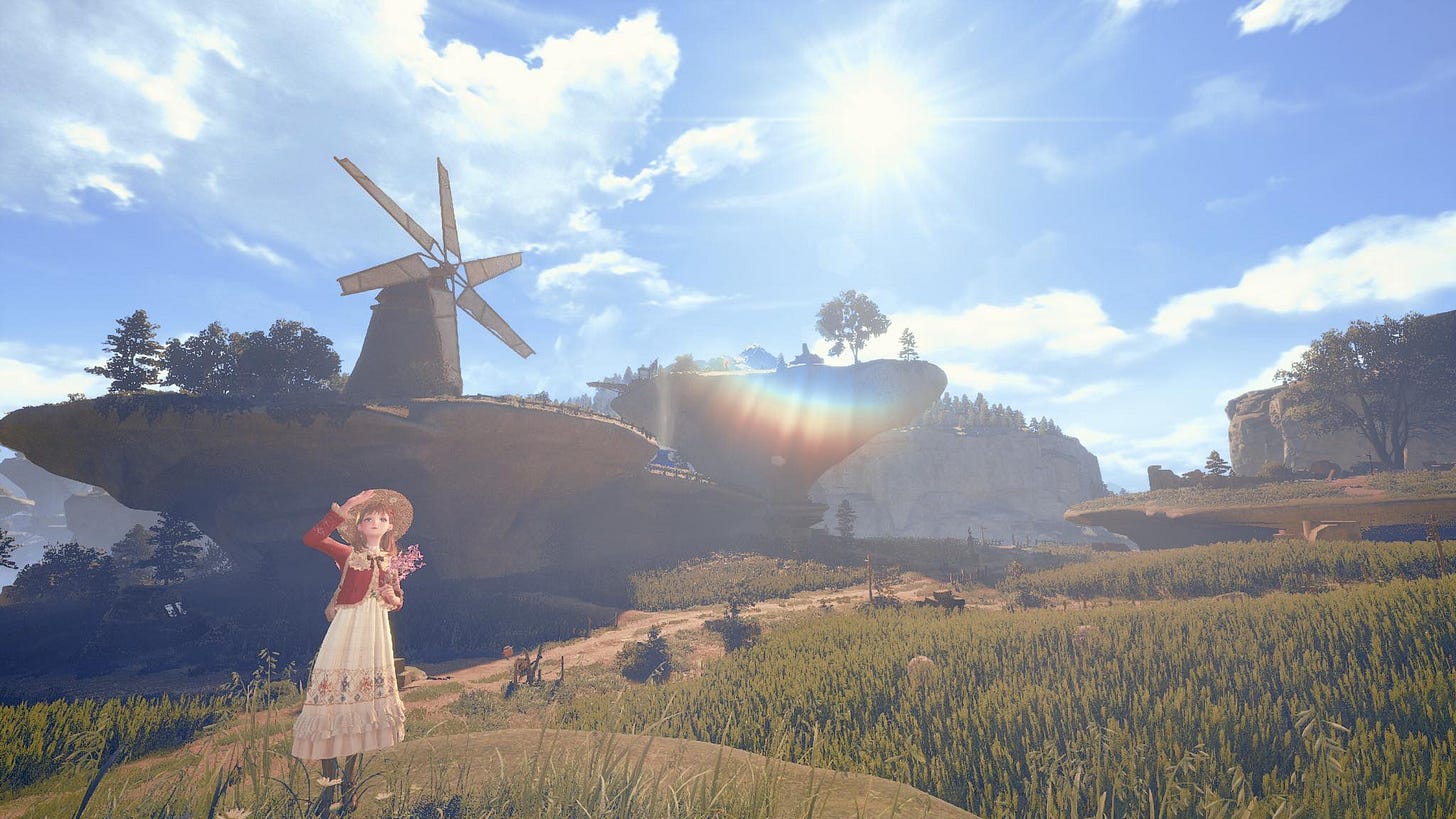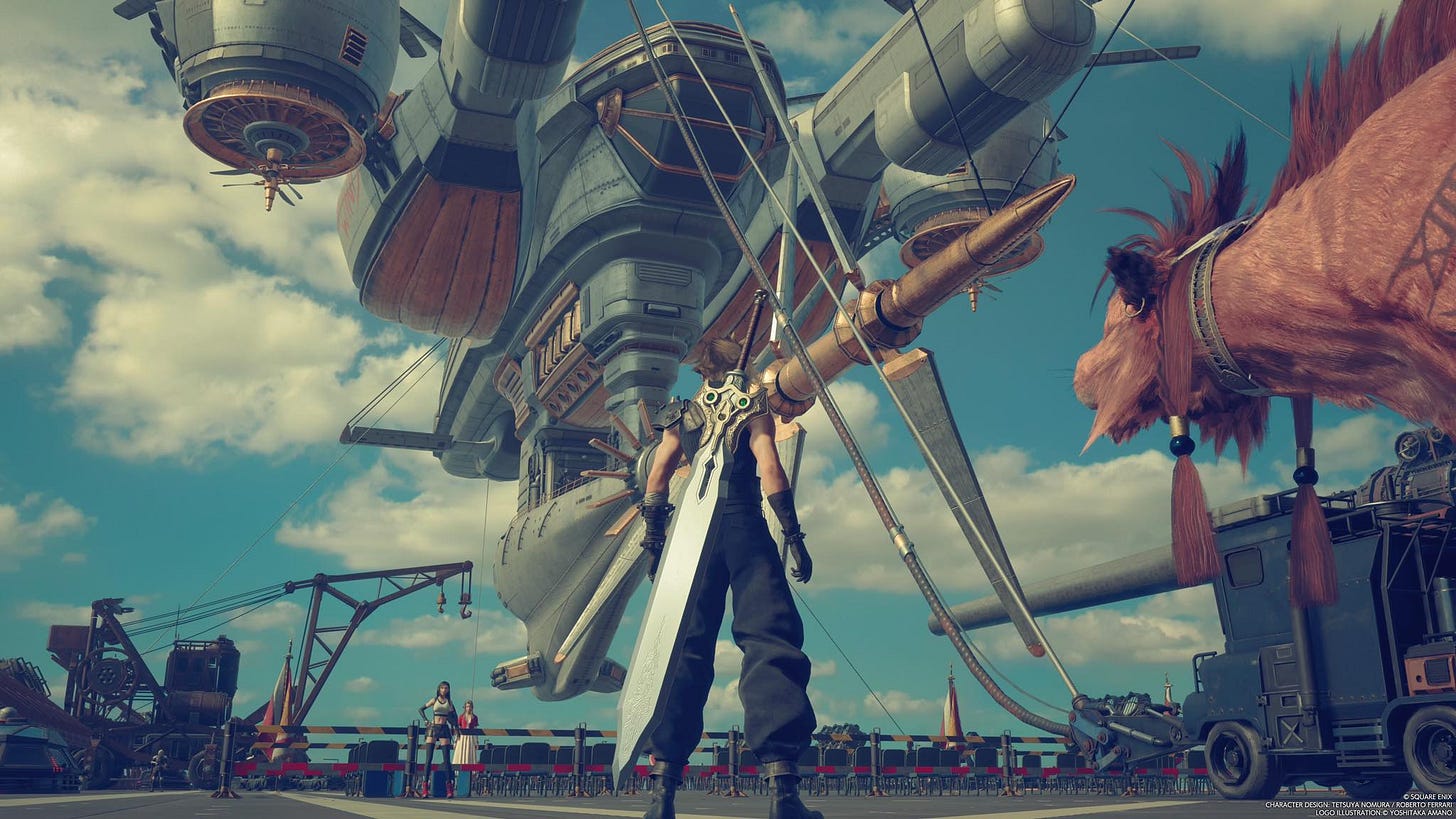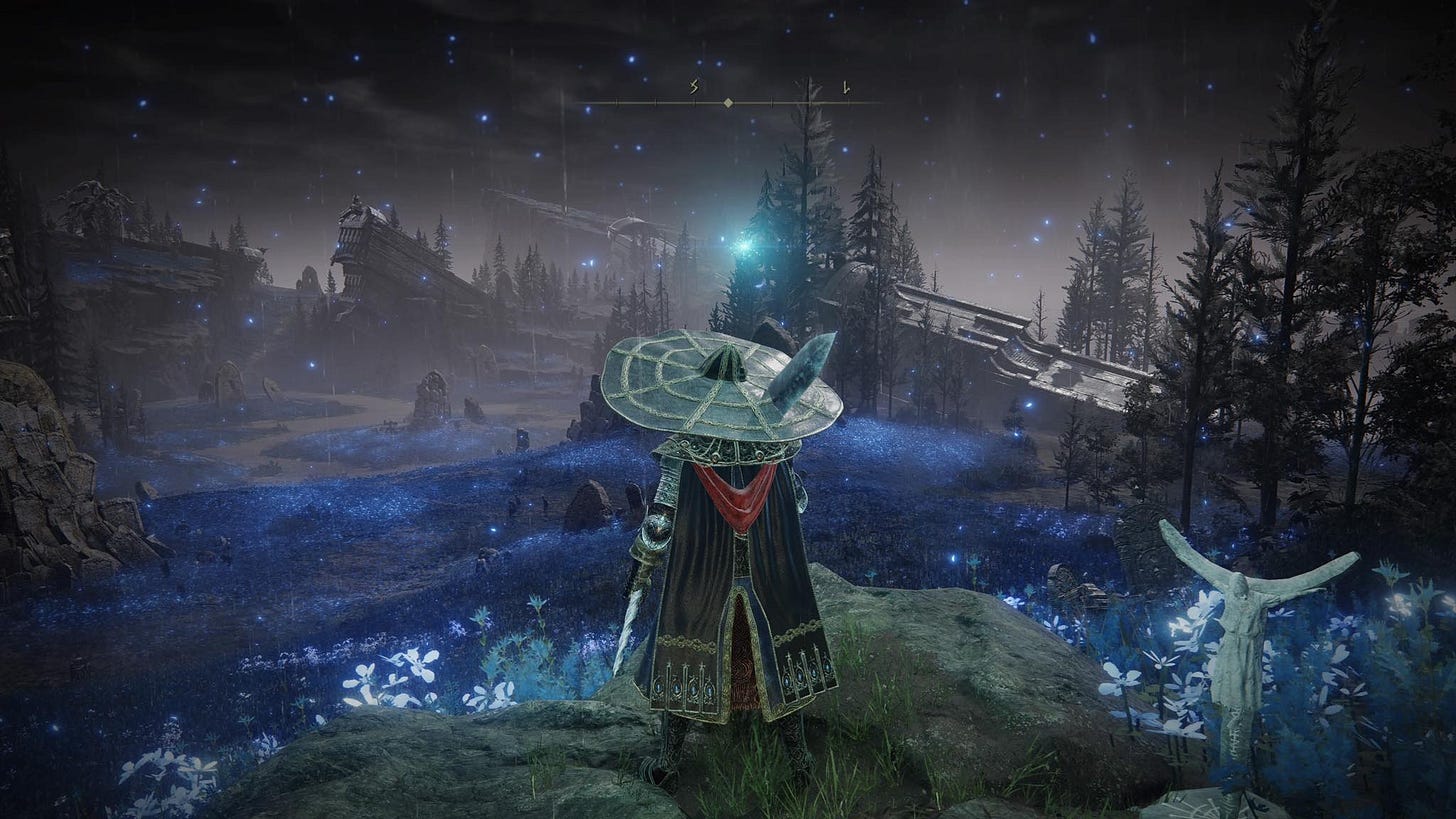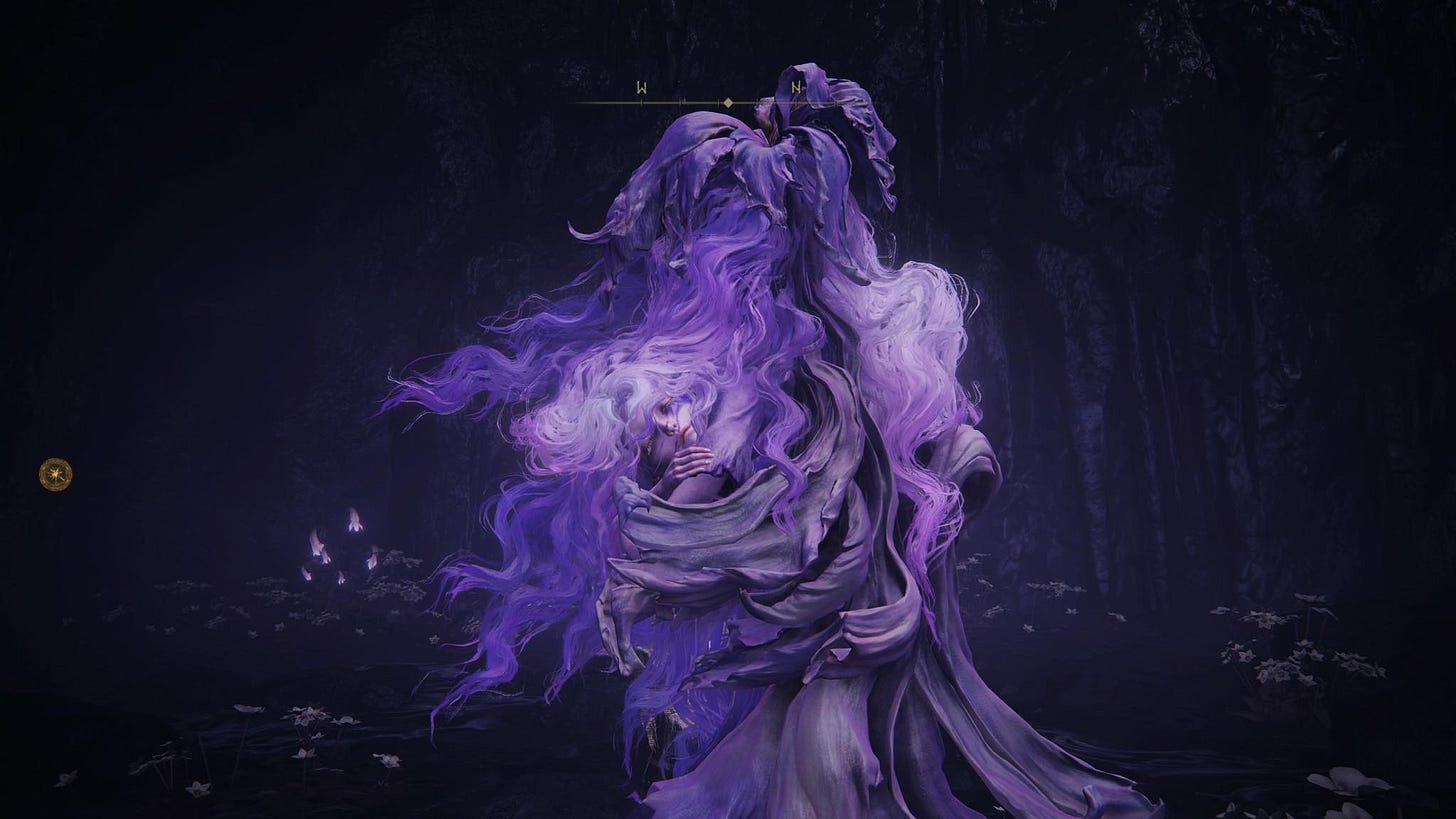Game of the Year 2024
Another year, another batch of games to talk about. Before we get to the honorable mentions and list proper, I wanted to mention that Seth Sturgill and I started a podcast this year, ostensibly about video game music, but kind of a whole lot of other stuff. From how we relate to other people from the art we enjoy to gross food habits, voodoo families, and growing up watching the Weather Channel, the show is kind of a crystalized version of us and our tastes from where we stand in 2024, all in the format of a longform podcast or radio show. We take emails, comments, and even voicemails, and it’s the most fun creative project I’ve ever worked on. It’s called Bit Harmony, and I sure would appreciate it if you took a listen; if you don’t wanna start at the beginning, I’d recommend the Super Monkey Ball or Tetris Effect episodes. And leave a 5 star review while you’re at it, dummy.
Now let’s talk about some games, yeah?
Honorable mentions:
Crow Country
A low-poly indie game directly inspired by horror games of the Playstation 1 era, most notably the first few Resident Evil games, with obtuse puzzles and an emphasis on replayability sounded like a dream game, and Crow Country didn’t disappoint: it’s everything I love about old horror games mixed with a modern design sensibility and set in a low budget local southern American theme park (how on earth has that setting not been used more often for games like this!?).
And while I love the low-poly look for games in general right now, it really proves its worth when it comes to horror games specifically; everything here has that layer of grainy, grimy, abstracted offness here that lends so many games of the mid to late 90s their atmosphere.
Crypt Custodian
Kyle Thompson has quietly and consistently been making some of the most solid indie games for a few years now, and Crypt Custodian is handily my favorite of his works yet. Waking up in the afterlife, you’re denied entry into the good place and instead assigned to cleanup duty by a frog lady that clearly has no good intentions for you. As you traverse a gloomy limbo and make friends with other deceased former pets, you concoct a plan to figure out what’s really going on. This involves a lot of platforming and combat from an overhead perspective while exploring some lovingly crafted otherworldly environments, gathering new abilities and partners in crime while you’re at it.
The combat is much more satisfying than you might expect based on how simple it seems in the early game, and the story ends up being a rather beautiful look at what missing people feels like when you’re the one that’s passed, all told in a very friendly and approachable manner. Add in one of the better soundtracks of the year, composed by Kyle’s brother Eric, and you’ve got a pretty unforgettable journey.
Castlevania Dominus Collection
It’s well documented that I am, among many other things, a dork for all things Castlevania. But as much as I’ve grown to love the series in its entirety, it was really the Nintendo DS entries, specifically Dawn of Sorrow, that made me a fan. So to have the entire DS trilogy available in absolutely pristine form on all modern hardware, with some much appreciated quality of life features, plus concept art scans and a jukebox for all the games included? What else could any Castlevania nut want?
Oh, I dunno, how about the bonus inclusion of a remake of Haunted Castle? While the original may have been an awful arcade-y take on the Castlevania mythos, Haunted Castle Revisited takes the general structure and setup of the original and makes it actually playable, not to mention lovely to behold with its downright gorgeously animated 16-bit era sprites and completely rearranged soundtrack. It’s an absolute love letter to a weird and overlooked corner of the series, and it’s just wedged inside of a collection of three of my favorite games of all-time! I didn’t know it could feel this good to care about Castlevania in 2024.
Mario & Luigi: Brothership
In a pretty weak year for Nintendo as a software publisher, a new entry in the Mario & Luigi series was at the very top of their most shocking announcements; this franchise was thought to be long dead, with the closure of longtime series developer, AlphaDream, years ago, and Nintendo already reviving both of their other Mario RPG spinoff series in the past year wasn’t really signaling that it was time for another one of these any time soon. What’s even more shocking than this game existing at all is just how much I like it, despite its flaws.
While the game inarguably takes too long to get going (and even when it does, manages to find itself bogged down by far, far too much uninteresting dialogue for a lot of its runtime), the battle system and bosses served up here are not only the best in the series, but I’d argue the best of any Mario RPG period. This is accomplished by coupling some of the best Max Fleischer-styled animations seen in a video game since Cuphead together with the plug system, an absolutely ingenious way of providing all kinds of passive benefits to the brothers in battle that actively forces you to think about each encounter and how you interact with every enemy type on the fly. With better pacing and a story and dialogue that weren’t so comatose, this would have been an easy top 10 contender, and maybe even an all-timer in the Switch library. As it stands, it ends up being a remarkably great attempt at a beloved series revival.
Arco
My de facto number 11 of the year, Arco feels like it came from a different universe. With its gorgeous pixel art, blood-soaked anti-colonialism story set in a fictional Mesoamerican-inspired world, and perhaps the most innovative turn-based battle system I’ve ever experienced, this list has no right existing if I didn’t shout the game out in some form or another. Truth be told, the main reason this didn’t make it on to the list proper is simply that the Switch version, where I was playing it, had a lot of technical issues that caused me to put it down, and I haven’t taken the time to go back to it yet. I hear it’s been patched since, and I look forward to taking the time to start over and sink my teeth in once again, because the chapters I experienced already earlier this year were nothing short of transcendent.
And now…….the list.
Like a Dragon: Infinite Wealth
Truthfully, I really, really wish I could rank Infinite Wealth higher than I have it here. This was poised to be an easy knockout, a direct sequel to Yakuza: Like a Dragon, my favorite entry in the longrunning series, which was the first to adopt a turn-based combat system, as well as introduced a new main character in Ichiban Kasuga. I mean, the premise for Infinite Wealth is basically Ichiban getting up to hijinx on a Hawaiian holiday; how could it not be incredible?
While the turn-based combat is massively improved here in too many ways to count (team attacks, easier and quicker access to a wider variety of jobs and abilities, and enemies that are mercifully far less tanky than the previous entry), it’s the story that ended up disappointing me here; Infinite Wealth sidelines Ichiban’s story pretty heavily in favor of bringing back series mainstay protagonist Kiryu Kazuma in an attempt to give him his, like, third or fourth sendoff game. I love Kiryu, and watching him interact with this group of characters as they help him contend with his own mortality and saying goodbye to the ones he loves is a genuinely great setup, but it’s to the point where he steals the show, especially when Ichiban’s side of the story feels like it’s lacking the usual Yakuza oomph.
In all other ways this is a fantastic entry though, delivering the usual charm, goofiness, introspection, and bombast that everyone fell in love with Yakuza over years ago, as well as maybe the best overall selection of minigames the series has ever seen; there’s an entire Animal Crossing-styled resort building minigame in here, for some reason, and it’s actually great? I just hope the next mainline entry is able to shift its focus and give Ichiban the proper attention he deserves.
1000xRESIST
1000xRESIST feels like a revolution in how storytelling can be handled in video games. It was developed at the height of the COVID-19 pandemic by a small group of people largely unfamiliar with game development, and not only does it show, but the game absolutely thrives because of it. Set in a world that suffers its own deadly pandemic (though their illness is brought on by a visiting alien species dubbed The Occupants), you see the world through the indoctrinated eyes of a clone (one of many) of the only human on earth that was immune, now known as The Allmother. You spend the first chunk of the game diving into memories from The Allmother herself, learning how she transitioned from being a pretty shitty teenager named Iris to the last bastion of humanity on the entire planet. And that’s just the first half of the game before things really pop the fuck off.
I don’t want to talk more specifics about the plot than that, mostly because 1000xRESIST is an entirely narrative-driven experience, and I truly think it’s one of the best stories yet told in the medium, one that should be experienced on your own; while that extremely succinct plot summary might sound heady and intimidating, at its core is a story about immigration, family, societal structure, and what it means to be human.
What I do want to shoutout, however, is just how amazingly told that narrative is. 1000xRESIST feels like a stage play in video game form, telling a story that could only be told properly as an interactive piece of entertainment, but with a professionalism and flair for the cinematic that games with 1000x its budget should aspire to. If there’s such a thing as required reading in the video game space, 1000xRESIST has already earned its spot at the head of the table.
Vividlope
Everything about Vividlope feels specifically designed to appeal to the most base parts of my dumb brain. Super fast-paced arcade-y puzzle gameplay that combines Pacman with Super Mario Galaxy? Dozens upon dozens of different enemies? Level gimmicks that keep you guessing up until the very end of its over 100 stages? Three playable characters, each with unique stats and gameplay hooks? An absolutely killer turn of the millennium aesthetic oozing out of every square inch of the game, from its soundtrack to its cel-shaded visuals to its Sega Dreamcast-ass menus and Windows ‘98 wallpapers? And a price point of less than 10 dollars!?
I’m keeping this entry relatively short, though if you’d like to learn more, I highly encourage you to check out my full review of the game from when it released on Switch earlier this year. Suffice it to say that I think Vividlope is an absolute masterpiece in the genre, and one that I would consider a must-play for just about anyone that likes this type of puzzler.
Infinity Nikki
The idea of a borderline predatory, microtransaction-heavy gacha game built around fashion and dressing up your character making it on to a personal game of the year list of mine would’ve been laughable to me as little as a few months ago. And yet such is the power of Infinity Nikki, the latest in the (apparently) long-running Nikki series, this time with an open world conceit.
Playing like some kind of dream game combination of Super Mario Odyssey and The Legend of Zelda: Breath of the Wild, Infinity Nikki feels like it fell out of a different universe in which free to play games aren’t all time and money black holes designed to make you only feel happiness when spending obscene amounts of money. To be clear, the prices of some of the premium outfits are downright offensive (like, a single outfit costing as much as an entire game kind of offensive), but it was hard for me to care about that when it was so much fun simply running, jumping, and gliding all over the world, looking for collectibles, doing quests, getting into fashion battles, and completing minigames in a completely scattershot manner. And unlike other contemporaries in the free to play space, Infinity Nikki is designed to have its story finishable without spending a dime, at least as of the time of this writing.
And look, I still have reservations about recommending this game wholeheartedly; anyone with a spending compulsion or gambling addiction should stay far, far away. There’s nothing I’d love more than for this game to just exist as a 60 dollar standalone release with everything unlockable within. And yet, despite all that, I can’t deny the sincerity and love that was poured into (and oozes out of) Infinity Nikki. There’s a sweet gentleness on display here, from the softness of the game’s colors to the way in which Nikki herself interacts with the world around her, that I don’t often get to see expressed in the male dominated space of video games; it makes this game feel like a revelation, an ode to femininity and the act of play that I wish we saw more of.
Maybe it’s sad that a game scientifically engineered to make you spend irresponsible amounts of money on digital dresses is something to be celebrated in the video game space, but for right now, what can I say? Infinity Nikki rules.
Final Fantasy VII Rebirth
This middle chapter of the Final Fantasy VII remake trilogy starts off basically where we left off in Remake. After a brief sojourn through Cloud’s memories in the form of a playable flashback, you’re brought forward to the city of Kalm and start getting a sense for both the state of the world since the party left Midgar, as well as the state of the 80 hour (at least) game you’re about to experience. Turns out, both things are an absolute mess — Shinra, the evil electric company steadily sucking the planet’s soul to power the world and gain a tighter grip on its control over society, is flailing around after their president was assassinated, and they’re looking to make an example of Cloud and co., all while the real threat, Sephiroth, is able to do his, uh, undefined evil stuff, relatively unchecked; meanwhile, you as the player are about to spend dozens upon dozens upon dozens of hours decidedly not saving the world, instead playing an obscene amount of minigames, primarily a card game while listening to jazz music.
Does that give you an idea of what Rebirth is and how I feel about it? No? Good! Because I think most of the time the game doesn’t understand what people even like about video games at all, and I certainly don’t know what my thoughts are on it nearly a year since it released. It’s maybe the most poorly paced video game I’ve ever played, getting in its own way at nearly every turn to inundate you with a bunch of shit that doesn’t really matter and only serves to blockade your enjoyment. Some of it is cute, and most of it is annoying. Looking back, I was annoyed most of the time while playing when I wasn’t in a battle or watching a cutscene. And yet, for some reason I absolutely love this game and am straight up frothing at the mouth for the finale.
I say for some reason, and yet I know exactly what those reasons are: the battle system is still one of the best I’ve ever experienced, a masterful blend of turn-based and action; its characters and how they’re written to interact with each other make them feel like old friends to me at this point, far removed from the broad stroke caricatures of the original game; and don’t even get me started on the soundtrack, made up of hundreds of songs, both rearrangements and new compositions, that put every other game released in recent years to shame, including its predecessor.
I’ll be there for part 3 no matter what. Just please, please, cut the amount of minigames in half (at least!) and keep what’s been great about these first two games, and we’re in for one hell of a finale. The promise has been made.
Dragon Quest 3 HD 2D Remake
As much as I love the Dragon Quest series, I was not expecting a remake of one of the earliest entries in the series to be my favorite RPG this year, especially a remake that was primarily an audio and visual overhaul as opposed to much significant in the way of content retooling. Yes, there are some new things here, such as a new vocation in the way of the monster wrangler (basically indispensible in the early game, trust me), as well as some quality of life features like a quest marker and the ability to commit any NPC dialogue to memory, able to be revisited at any time from a menu instead of having to track down a specific character again. Overall though, I was concerned the game would be too basic, having originally released in 1988.
And for some people I think that will undoubtedly be the case; the writing and plot are much less emphasized here than even the immediate next entries in the series, and the game’s combat can be extremely unforgiving if you’re coming to this as a first-time Dragon Quest player. For me, though, I think my enjoyment of the game was actually because it consisted entirely of the meat and potatoes; turning off the previously mentioned quest marker feature and raw dogging my stats turned the game from a fairly straightforward and basic RPG to an odyssey in which I was getting lost for sometimes hours at a time, entering the wrong neighborhood of some fairy woods and paying dearly for it.
I found myself not only enjoying getting lost in the game’s world, but actively looking forward to it; I reveled in my flawed party composition, and absolutely refused to change my martial artist’s vocation despite the fact that he was my team’s biggest liability and least useful teammate for the vast majority of my 50 hours with the game. I didn’t care that my stats weren’t minmaxed with the right character personality and vocation combinations, because this all felt like my journey and my story and my absolutely useless martial artist, and I wouldn’t have it any other way, dammit. And by the end my team was basically indestructible anyway, so even Richter the martial artist got there eventually (even if he did have to become a sage along the way).
It’s funny that a nearly 40-year-old game is showing up most modern RPGs when it comes to the amount of freedom on offer. Ultimately I don’t expect DQ3 to majorly change anything when it comes to the direction modern RPG design is headed, but as long as we still occasionally get games of this quality and depth to their systems, I’ll take what I can get.
Gimmick! 2
It’s not very often that I encounter video games that feel truly new, and it’s been outright decades since I felt that about a sidescrolling platformer, a genre that at one point was so ubiquitous it was basically synonymous with the medium. Hell, I wasn’t even particularly interested in Gimmick! 2 beyond it being a curiosity — a sequel to an over 30-year-old obscure, hard-as-nails, physics-based platformer that was only released in Japan and Scandinavia? Uh, ok, sure.
Maybe it was because of my somewhat dismissive attitude that Gimmick! 2 managed to shake me to my platformer loving core though, because this game absolutely rocked my ass. The aforementioned physics-based platforming, accomplished by summoning forth a star from the ether and bouncing it off of various surfaces at the correct angle to be able to hop on and hitch a ride in time, had me reexamining how I interacted with and even viewed a game in which the only verbs available to you are “jump” and “throw”.
Sure, the game starts off simple enough, at least until you realize that you managed to somehow miss the majority of collectible chests in even the opening stage. It’s when you go back in to revisit an early level, on the hunt for a new hat to dress your little dude up in, you spy a chest that seems completely inaccessible, and you realize that you somehow have to:
bounce your star at a wall so that it shoots back at you, allowing you to hop on it and skip you across a lake
jump off your star in mid lake-skipping to a higher platform
bounce a second star at another wall at just the correct angle so that it comes up beneath you while still giving you the proper height to make it to that chest that seemed unattainable when you started this whole process half an hour ago
That’s the moment when the brilliance in the design of Gimmick! 2 is revealed, where the impossible seems at least a little bit kinda sorta possible, in which I realized I was experiencing a modern platforming masterpiece.
Super Monkey Ball Banana Rumble
After over 20 years of almost nothing but fall outs, who knew Monkey Ball was still capable of one like this? The series was a childhood favorite of mine on the GameCube, but quickly fell way to irrelevance with mostly gimmick-focused releases that lost sight of basically everything that made the original games great while also failing to add anything worthwhile on their own (besides some great soundtracks, admittedly). I mean, a jump button? In a Super Monkey Ball game? Come on.
And while the initial reveal of Banana Rumble didn’t inspire much hope in me, from its trailer focused on multiplayer modes and the game’s central spindash gimmick to even its name (it is a bad name, to be fair), Sega managed to put out not only the best game in the series, but probably my favorite marble rolling game ever. Turns out that fantastic level design and a central gimmick that actually makes sense for and compliments said stages is really all the series needed. And boy is that spindash mechanic good, to the point where it’s hard to imagine going back to any of the previous games without it.
With an absurd amount of levels (well over 200 of them, each with five optional challenges to complete), half a dozen different modes in just the single player alone, and significant free updates having happened multiple times since the game’s initial release, it might genuinely be the most content rich game on this list, and one I’ll be going back to for dozens and dozens of hours still.
Nine Sols
I’ve never felt as cool playing a video game as I did fighting basically any boss in Nine Sols. Not at first, mind you, and maybe not even for the first hour’s worth (or several) of attempts against any given boss. But by the end, every fight felt like an elegant, intricately choreographed dance in which I was the lead. Even in my victories I would have stumbles here and there, but in the moment, when I was flowing and slicing through the game like sharpened, weaponized air, who would even notice? Certainly not me.
Don’t let anyone convince you that Nine Sols is a metroidvania. Yes, in the broad strokes it is, but that’s not the appeal of it. Not really. It’s a duel simulator with long stretches of exploration and (shockingly great) storytelling in between the duels to get you ready and up to snuff for your next grueling performance. You’ll find your next target, groan when you realize you’re in for an extended period of repeatedly getting your ass stomped before you even manage to beat the first phase (wait, there’s multiple phases!?). You’ll have ups and downs, attempts where you scream because the boss had “just a couple hits left”, and other attempts where you scream because you were killed by the opening combo because you’ve accidentally been trying this for two hours and your mind has turned to mush. Despite all of that, you will still succeed. And at the end of it, you will feel just as cool as I did, if not cooler.
Until you get to the next duel and start it all again.
Elden Ring: Shadow of the Erdtree
This is probably the most boring number 1 placement possible from me. Honestly, it was probably a lock for game of the year for me from the reveal trailer. But who am I to deny my base nature and preferences? It’s more Elden Ring, dammit. And Shadow of the Erdtree is simply the best game I played this year (though Nine Sols comes closer than you might expect), and is also larger and far more dense than most standalone games from other big publishers.
Adding an absurd amount of new weapons, abilities, spells, armor, summons, and bosses to a base game already stuffed to the point of bursting would have been more than enough to satisfy me, but developer Fromsoft had the audacity to make an entirely new open world continent, the Land of Shadow, to explore. Far more dense and far more beautiful than anything from vanilla Elden Ring, the Land of Shadow manages to combine the open world design of Elden Ring with the more puzzle-y nature of the Dark Souls games to create a world in which it’s not as easy as simply seeing a landmark in the distance and pointing your steed in that direction anymore; there are vertical layers upon layers to consider in this expansion, and figuring out how to navigate what feels like four separate areas stacked on top of each other was half the joy for me.
Most satisfying and fun for me were the new revelations and upheavals to established Elden Ring lore. My wife and I spent the better part of two years passionately discussing our theories about this game’s world, and I personally couldn’t have asked for a better closure (I assume?) to the story. In classic Fromsoft fashion, we were left with just as many questions as answers, but to finally at least be given firm(ish) confirmation on the nature of all the Two Fingers and their relationship with the Greater Will felt extremely gratifying. And don’t even get me started on the subtle reveal of Marika’s past and a recontextualization of all the heinous things she’d done; yes, she’s still a monster, but a relatable one, and I full on wept upon reaching her home village, waves of realization crashing on me; it was by far and away my personal favorite story moment in a video game this year, and possibly of all-time.
In 2022, I didn’t know how Elden Ring would be able to be topped in the action RPG department, and yet its own expansion was able to surpass it in all measurable ways just two years later. I prepare to enter 2025 not knowing how either Shadow of the Erdtree or this entire damn year for video games will be topped any time soon. But I’m more excited than ever to keep playing video games if I keep getting experiences as varied and high quality as this top 10 list.

